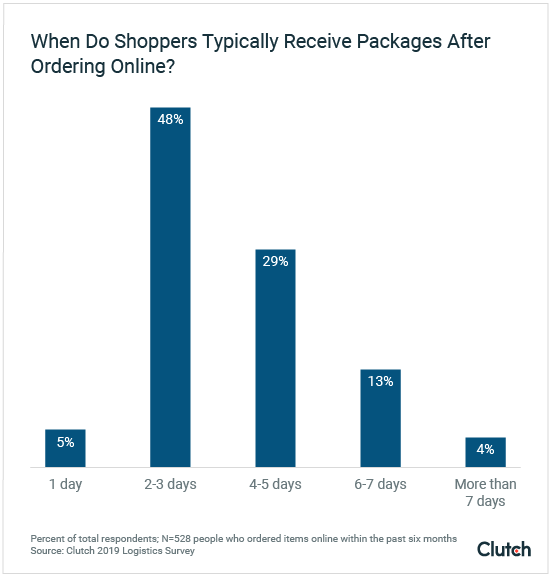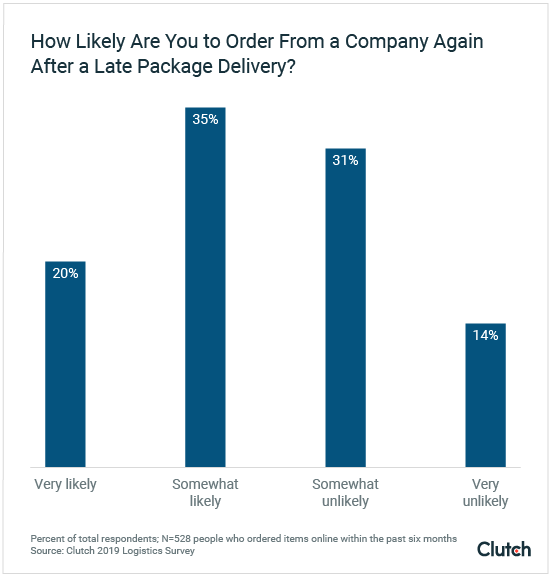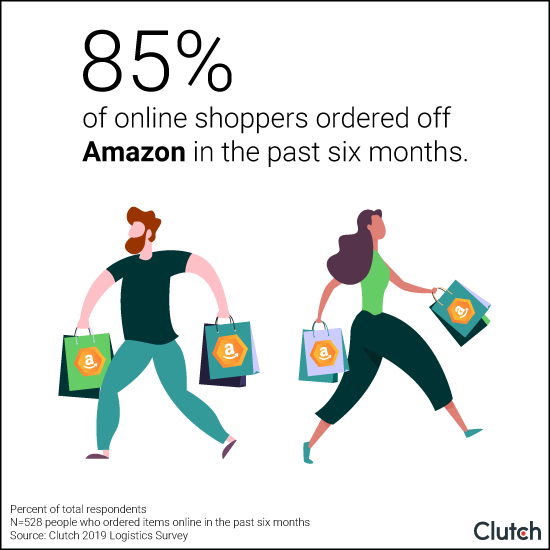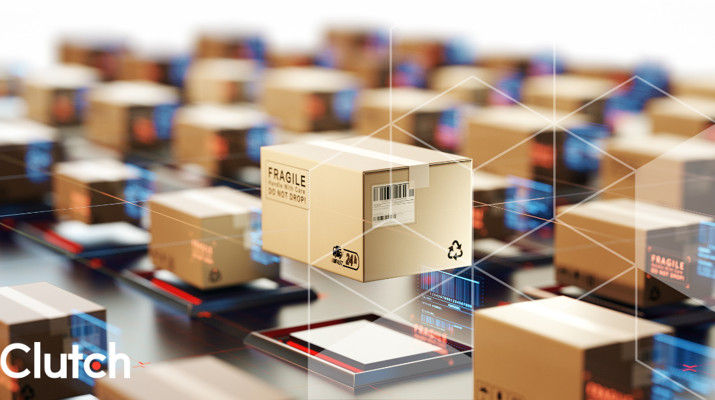

Updated December 20, 2024
In 2019, e-commerce giants sought to stand out to online shoppers by providing faster and cheaper shipping options, and small businesses felt the pinch. Amazon continues to set the standard for the e-commerce industry with its widely available two-day shipping option and growing same-day shipping option. Yet, customers who demand fast shipping may not realize how increasingly expedited delivery timelines affect small businesses that cannot offer quick shipping affordably.
Updated April 1, 2022
In 2016, online shoppers expected to wait 4.8 days for a package delivery. In 2019? The largest percentage (48%) said they typically received a package within 2 to 3 days, according to Clutch’s data.
Looking for a Logistics & Supply Chain Consulting agency?
Compare our list of top Logistics & Supply Chain Consulting companies near you
Deliveries must move fast in the age of online shopping. Customers may not understand what exactly goes into getting a package to their doorstep in 2 to 3 days, though – and that their expectations for faster shipping have consequences, including pricing out smaller, local retailers that cannot offer fast shipping on the scale of major online retailers.
The small business landscape a few years ago was different. One in 12 small businesses close every year. Yet, 90% of Americans shop at small businesses weekly, and small businesses create 66% of new jobs annually. Consumers care about small businesses, but they also crave fast package delivery.
In 2019, Clutch surveyed 528 online shoppers to learn how quickly they typically receive packages and their opinions on shipping times.
Our report can help:
Explore our directory of logistics service providers on Clutch.
The typical package delivery timeline has shortened, resetting online shoppers’ expectations. Small businesses are adjusting their shipping strategies to keep up with larger online retailers.
In 2019, almost half of online shoppers (48%) said they receive packages in 2-3 days, and 5% typically receive packages in just 1 day.

In April 2014, packages usually took 6.3 days to be delivered, according to Rakuten Intelligence.
Shipping stands out as a key differentiator among online retail giants that fight to gain an edge in the competitive e-commerce market. Small businesses must modify their strategies to compete with the likes of Amazon.
Jeff Moriarty is the marketing manager for Moriarty's Gem Art, a custom jewelry store in Indiana. He said that five years ago, his business shipped packages the cheapest way it could with insurance. That has since changed.
“Now, everything is shipped Priority Mail, with 2- to 3-day delivery to [the customer’s] location,” Moriarty said.
Faster shipping can complicate the production of items for small businesses, though. Kara Buntin, owner of A Cake To Remember, a cake-decorating supplies shop, changed the number of made-to-order items she offers to meet customers’ shipping expectations.
“I recently unlisted an entire category of items that took a little longer than average to make and ship, and I'm concentrating on selling things that are ready-to-ship,” Buntin said. “I make more things ahead [of time] and am able to get them in the mail the day after they're ordered, if not the same day.”
Small businesses struggling to fulfill and ship orders quickly may want to investigate if they can streamline their offerings like Buntin did.
Sebastien Gibert is the director of The Hideout Clothing, a male streetwear clothing line based in Trinidad and Tobago. Gibert noticed that many U.S.-based shoppers abandoned their carts after seeing the high cost of shipping needed to profitably send clothing from the Caribbean.
“We knew that customers were not willing to pay excessive amounts for shipping,” Gibert said. “As we continued to grow, we eventually got a warehouse in Florida where we pack and ship from.”
Whereas shipping from Trinidad and Tobago could cost Gibert upwards of $23, it cost about $8 to ship from Florida.
The Hideout Clothing’s Florida-based warehouse allows the company to offer free and fast ground shipping in the U.S., helping it better meet online shoppers’ shipping expectations.
These small business examples show how to reevaluate and reshape shipping strategies to meet consumers’ desire for fast shipping.
Did your business send a package late? Expect consequences.
Customers may abandon a company if a package is delivered late. Small businesses can mitigate the negative consequences of longer delivery timelines by communicating consistently and transparently about the items’ arrival dates.
Nearly half of online shoppers (45%) said they were unlikely to purchase from a business again if a package was delivered late in 2019.

Ross Palmer is the digital marketing manager of Lab Society, a laboratory supply company. It’s difficult for Lab Society to implement streamlined, fast shipping because it largely sells industrial, scientific items. Delivery timelines were especially complex when customers ordered small and large items together.
“We found that matching [small and large items] together wasn’t the right way to go,” Palmer said, stating that the company often had to wait on the manufacturer to finalize the large items when the small items could be shipped immediately.
Now, Lab Society ships the items separately when they are ready to go, while keeping customers as up-to-date as possible on the delivery dates for all the items.
“Recently, we unrolled new automatic shipment separation,” Palmer said.
Automatic shipment separation works by automatically dividing the items at checkout that must be shipped separately. Lab Society notifies customers if a large specialty items requires freight shipping, as opposed to Lab Society’s standard shipping, and tells them that a company representative will contact them within 48 hours of their purchase to discuss delivery timelines and costs.
The upfront and consistent communication helps mitigate customers’ frustration: “Our customers appreciate the clarity and insight before their purchase, rather than dealing with unexpected problems after,” Palmer said.
“Our customers appreciate the clarity and insight before their purchase, rather than dealing with unexpected problems after."
It’s important for small businesses to recognize their limits when it comes to shipping items and not to make promises they can’t keep. Otherwise, they risk facing backlash from customers when orders aren’t fulfilled in time.
Joel Poznansky is the owner of Wicked Uncle, an online specialty children’s gift retailer based in the United Kingdom. It started doing business in the U.S. in 2017. Poznansky said that shipping expectations became an issue when the company began selling in the U.S., where consumers are spread out over longer distances than in the U.K.
“With gifts, including birthday gifts, offering an overnight option was too painful,” Poznansky said. “Although it costs us some sales, we have to live with it to ensure goodwill continues.”
Poznansky recognized that consistently sending packages late wasn’t worth the extra sales that falsely promising overnight delivery offered.
Small businesses may be tempted to offer faster shipping to gain customers, even if those orders are difficult to fulfill in time. Instead, small businesses should be transparent about delivery timelines and communicate consistently with customers if shipping will take longer.
Amazon’s massive size allows it to take advantage of cutting-edge technology, new methods of transportation, and economies of scale that smaller businesses don’t often have access to.
Smaller businesses may want to consider using third-party logistics providers, or 3PLs, whose business is solely built around fulfilling orders for other brands.
Stephen Miller is the manager of sales operations at Dotcom Distribution, a third-party logistics provider. He said many small businesses can’t meet fast shipping expectations affordably alone because they don’t have access to the advanced technology that streamlines the process.
“[The advanced technology] is cost prohibitive and takes away from the core focus of the individual brands,” Miller said. “Fulfillment companies take that responsibility so [small businesses] can concentrate on their marketing, sourcing, and supply chains.”
“Fulfillment companies take that responsibility so [small businesses] can concentrate on their marketing, sourcing, and supply chains.”
3PLs allow small businesses to access the economies of scale that e-commerce giants such as Amazon have built to ship quickly.
Amazon itself even offers fulfillment services that small businesses can use. Millions of “third-party sellers” sell and ship their items through Amazon, though Amazon struggles to regulate these products and to punish retailers selling unsafe products.
Small businesses should seek outside help to take advantage of the manpower and technology required to profitably ship many orders within days.
The e-commerce industry allows consumers to purchase an endless variety of items with a few simple clicks of their mouse. When ordering an item online is such a seamless process, online shoppers may not realize the enormous effort required to deliver packages on a 2- to 3-day (or less) timeline.
Consider the typical journey of a package ordered off Amazon:

Amazon continues to dominate the e-commerce space, popularizing its promise of fast shipping throughout the whole e-commerce industry.
More than 8 in 10 (85%) online shoppers ordered off Amazon in a six-month span of 2019. About 54% of respondents used the next most popular e-commerce retailer, Walmart.

Experts agree that Amazon is the primary contributor to consumers’ expectations for shipping. Previously, fast shipping didn’t make economic sense for businesses.
“Even 4-5 years ago, I had to pay steeply for just getting a two-day FedEx,” said Ram Krishnan, chief marketing officer of Aera. “Those logistics options were available, but they were cost-prohibitive. If I want to get a $10 thing [in two days], I’m going to pay $20 on the shipping.”
Amazon consumerized the shipping process by promising two-day shipping as part of its Prime membership. Now, other e-commerce companies large and small are expected to keep up.
“Amazon's domination is forcing merchants to compete with more delivery options, unique experiences, and faster-than-ever delivery times,” said Jessica Thiele, director of marketing at VL OMNI, an e-commerce integration platform.
In fact, Amazon Prime members were more likely to say 2-3 days is the maximum acceptable shipping time for a package. One in five non-Prime members (20%) wanted their packages in 2-3 days, compared to 31% of Prime members.
Amazon, as the largest e-commerce retailer, is setting the overall industry’s standards for shipping.
Consumers want their online orders quickly. Small businesses must adjust their shipping strategies to compete or risk losing sales to larger e-commerce giants with more shipping capabilities.
Small businesses should:
In the end, however, online shoppers may also need to reconsider the reality of their delivery expectations. Online shopping can make the hard work behind seamless deliveries become invisible.
“The consumer [needs to] scrape the surface and question how on earth they can push a button one evening and get the jumper they’ve ordered the following day,” said Neil Derrick, Yorkshire regional secretary at Britain’s General Union, speaking on the exploitation of workers at an e-commerce company’s warehouse.
Two-day shipping may be becoming the new standard, but it’s not without consequences.
Clutch surveyed 528 people who ordered a package online in a six month span in 2019.
More than half of the respondents (66%) are female, and 34% are male.
The respondents' ages are as follows: 18 to 24 (16%), 25 to 34 (33%), 35 to 44 (26%), 45 to 54 (16%), and 55 to 64 (9%).
Respondents are all based in the U.S., either in the South (42%), Midwest (21%), Northeast (17%), or West (14%).


